|
|
|
BONNET, J.
Architecture de la Renaissance. Coupole de Sainte-Marie-des-Fleurs à Florence [ Beau lavis original ] On joint : Plan de Sainte-Marie-des-Fleurs [ Santa Maria del Fiore ]
2 lavis sur beau vélin à lavis Canson & Montgolfier au format, 49,5 X 29 cm, datés du 11 et 19 septembre 1907, numérotés 103 et 104 (partie d'une série de lavis originaux), signée J. Bonnet.
Bookseller reference : 29791

|
|
|
BONNET, J.
Architecture Romane. [Lot de 7 beaux lavis originaux ] Façade du XIe siècle - Eléments de l'art roman. Les voûtes - Portes et Fenêtres romanes - Eléments du style rman. Roses du XIIe siècle - Colonne byzantine - Quelques ornements - Colonnes et piliers romans.
7 lavis sur beau vélin à lavis Canson & Montgolfier au format, 49,5 X 29 cm, datés de 1906-1907, numérotés 76, 77, 56, 85, 85, 84, 72, 74 (partie d'une série de lavis originaux), signée J. Bonnet.
Bookseller reference : 29792

|
|
|
BONNET, J.
Architecture Gothique. [ Lot de 10 beaux lavis originaux ] Eléments de l'art gothique. Fenêtre à lancette. Triforium et clérestory de Notre-Dame d'Amiens - Fenêtres flamboyantes. Eglise Saint-Ouen de Rouen. Claire-voie continuant les fenêtres supérieures - Fenêtre rayonnante. Sainte-Chapelle de Paris - Eléments de l'art ogival. Théorie de l'arc-boutant - Rose rayonnante XIVe siècle - Art gothique. Eléments du style ogival tertiaire (XVIe siècle) - Art gothique. Tombeau de François II et de Marguerite de Foix par Michel Colombe. - Eléments du Style ogival : Contreforts et arcs-boutants. Coupe de la Cathédrale de Bourges - Piliers et Colonnes gothiques (Types) - Les Voûtes. Voûte ogivale cupoliforme, domicale ou Plantagenêt
10 lavis sur beau vélin à lavis Canson & Montgolfier au format, 49,5 X 29 cm, datés de 1906-1907, numérotés 96, 94, 88, 82, 95, 97, 100, 81, 89, 83 (partie d'une série de lavis originaux), signée J. Bonnet.Rappel de la liste des oeuvres : Eléments de l'art gothique. Fenêtre à lancette. Triforium et clérestory de Notre-Dame d'Amiens - Fenêtres flamboyantes. Eglise Saint-Ouen de Rouen. Claire-voie continuant les fenêtres supérieures - Fenêtre rayonnante. Sainte-Chapelle de Paris - Eléments de l'art ogival. Théorie de l'arc-boutant - Rose rayonnante XIVe siècle - Art gothique. Eléments du style ogival tertiaire (XVIe siècle) - Art gothique. Tombeau de François II et de Marguerite de Foix par Michel Colombe. - Eléments du Style ogival : Contreforts et arcs-boutants. Coupe de la Cathédrale de Bourges - Piliers et Colonnes gothiques (Types) - Les Voûtes. Voûte ogivale cupoliforme, domicale ou Plantagenêt
Bookseller reference : 29793

|
|
|
BONNET, J.
Eléments de l'art gothique. Plan de la Cathédrale de Séez [ Beau lavis original ]
Lavis sur beau vélin à lavis Canson & Montgolfier au format, 49,5 X 29 cm, datée du 25 août 1906, numérotés 87 (partie d'une série de lavis originaux), signée J. Bonnet.
Bookseller reference : 29794
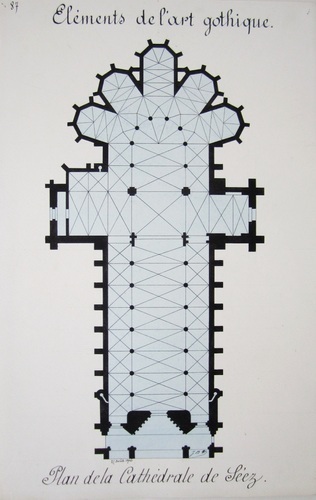
|
|
|
BONNET, J.
L'art gothique. Eglises à une seule nef. Cathédrale d'Albi. Coupe sur la nef [ Belle aquarelle originale ] On joint : Plan de la Cathédrale d'Albi
2 lavis sur beau vélin à lavis Canson & Montgolfier au format, 49,5 X 29 cm, datés du 12 septembre et 12 octobre 1906, numérotés 98 et 99 (partie d'une série de lavis originaux), signée J. Bonnet, d'après Corroyer.
Bookseller reference : 29795

|
|
|
BONNET, J.
L'art Gothique. Architecture militaire [ Lot de 3 beaux lavis originaux sur Carcassonne ] La Cité de Carcassonne : Vue du Château prise de l'angle nord-est - Remparts nord-ouest. Tour romano-wisigothe - Cité de Carcassonne. Plan au XIIIe siècle.
3 lavis sur beau vélin à lavis Canson & Montgolfier au format, 49,5 X 29 cm, datés de septembre et novembre 1906, numérotés 90, 91, 92 (partie d'une série de lavis originaux), signée J. Bonnet, d'après Corroyer
Bookseller reference : 29796
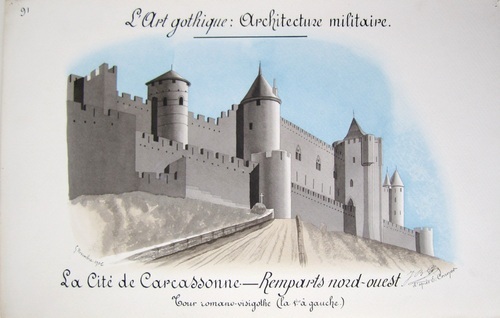
|
|
|
BONNET, J.
Coupe transversale et Vue intérieure d'une Basilique civile [ Belle aquarelle originale ] On joint : Basilique païenne et basilique chrétienne
2 lavis sur beau vélin à lavis Canson & Montgolfier au format, 49,5 X 29 cm, datés du 5 février et 23 janvier 1906, numérotés 53 et 54 (partie d'une série de lavis originaux), signée J. Bonnet, d'après Mallet.
Bookseller reference : 29797

|
|
|
BONNET, J.
Architecture carlovingienne. Eglises à coupoles. Eglise de Saint-Front, à Périgueux. Coupe transversale du nord au sud [ Belle aquarelle originale ] On joint : Eglise de Saint-Front. Fragment du Plan.
2 lavis sur beau vélin à lavis Canson & Montgolfier au format, 49,5 X 29 cm, datés de septembre 1906, numérotés 70 et 69 (partie d'une série de lavis originaux), signée J. Bonnet
Bookseller reference : 29802

|
|
|
BONNET, J.
Architecture carlovingienne. Architecture romane primordiale (Carlovingienne). Eglise de Vignory (Haute-Marne). Plan et coupe transversale de la Nef. [ Belle aquarelle originale ]
1 lavis sur beau vélin à lavis Canson & Montgolfier au format, 49,5 X 29 cm, datés de octobre 1906, numéroté 71 (partie d'une série de lavis originaux), signée J. Bonnet
Bookseller reference : 29803

|
|
|
BONNET, J.
Eléments du style roman : Clocher de Tracy-le-Val [ Belle aquarelle originale ]
1 lavis sur beau vélin à lavis Canson & Montgolfier au format, 49,5 X 29 cm, datés de février 1907, numéroté 75 (partie d'une série de lavis originaux), signée J. Bonnet, d'après Mallet
Bookseller reference : 29805

|
|
|
BONNET, J.
Art d'Egypte. [ Lot de 7 lavis et un pastel originaux ] Pyramide de Chéops. Coupe du Sud au Nord - Plan du Temple de Louqsor - Pylônes et obélisques de Louqsor - Colonne de la salle hypostyle du Palais de Karnac - Un colosse du Palais de Louqsor - Sphinx - Colonnes et piliers égyptiens - Le canon des égyptiens et de Polyclète
7 lavis et 1 pastel sur beau vélin à lavis Canson & Montgolfier au format, 49,5 X 29 cm, datés de 1905 (partie d'une série de lavis originaux), signée J. Bonnet.Rappel de la liste des oeuvres : Pyramide de Chéops. Coupe du Sud au Nord - Plan du Temple de Louqsor - Pylônes et obélisques de Louqsor - Colonne de la salle hypostyle du Palais de Karnac - Un colosse du Palais de Louqsor - Sphinx - Colonnes et piliers égyptiens - Le canon des égyptiens et de Polyclète
Bookseller reference : 29807

|
|
|
BONNET, J.
Coupe longitudinale du Panthéon d'Agrippa, aujourd'hui Eglise Santa Maria Rotonda [ Beau lavis original ] On joint : Plan du Panthéon d'Agrippa
2 aquarelles sur beau vélin à lavis Canson & Montgolfier au format, 49,5 X 29 cm, datés de septembre 1905, numérotés 35 et 36 (partie d'une série de lavis originaux), signée J. Bonnet
Bookseller reference : 29811

|
|
|
BONNET, J.
La Maison Carrée à Nîmes [ Beau lavis original ] On joint : Plan géométral de la Maison-Carrée à Nîmes
2 aquarelles sur beau vélin à lavis Canson & Montgolfier au format, 49,5 X 29 cm, datés d'octobre 1905, numérotés 35 et 36 (partie d'une série de lavis originaux), signée J. Bonnet, imité de CLefèvre et de Ch. Blanc
Bookseller reference : 29812
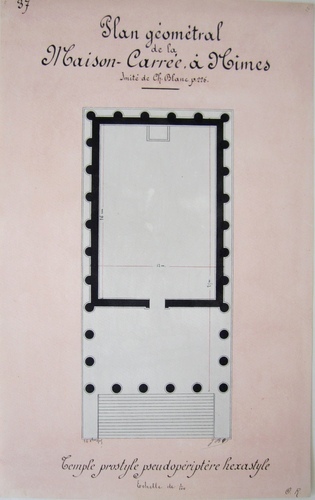
|
|
|
BONNET, J.
Colonne Trajane [ Belle aquarelle originale ]
1 aquarelle sur beau vélin à lavis Canson & Montgolfier au format, 49,5 X 29 cm, datés de novembre 1905, numérotée 42 (partie d'une série de lavis originaux), signée J. Bonnet, imité de CLefèvre et de Ch. Blanc
Bookseller reference : 29813

|
|
|
BONNET, J.
Sculpture de la Renaissance [ Lot de 8 aquarelles, lavis et dessins à la plume originaux ] Tombeau de Louis XII à Saint-Denis par la famille Juste - "Il Pensiero" d'après Michel-Ange - "La Pieta" de Michel-Ange - Saint-Georges par Donatello - Moïse d'après Michel-Ange - Tombeau de Philippe de Chabot d'après Jean Cousin - La Victoire et la Renommée, bas-relief de Jean Goujon, au Louvre de Lescot - Les Trois Grâces d'après Germain Pilon
8 lavis et aquarelles sur beau vélin à lavis Canson & Montgolfier au format, 49,5 X 29 cm, datés de 1908, numérotés 113, 114, 105, 115, 135, 131, 132, 133 (partie d'une série de lavis originaux), signés J. B. (J. Bonnet)
Bookseller reference : 29815

|
|
|
BONNET, J.
Art [ Lot de 33 aquarelles, lavis et dessins au crayons originaux ] Trois artistes du XVe siècle - La Cène d'après Léonard de Vinci - La Joconde - Raphaël - Michel-Ange - La Belle Jardinière d'après Raphaël - Jérémie - Christ au Tombeau d'après Titien - Noces de Cana (groupe d'après Véronèse) - François Ier et Elisabeth d'Autriche (d'après Clouet) - Sainte Elisabeth de Hongrie d'après Murillo - La Vierge de Douleur d'après Luis de Moralès - Vélasquez - Rubens - Van Dyck - Vierge au Saint Jérôme d'après Le Corrège - Le Coupe de Lance par Rubens - Rembrandt - Cloître de Moissac : Vue perspective des Galeries - Enceinte d'Avignon : Courtines, tours, créneaux, machicoulis - Alhambra de Grenade. Cour des Lions - Architecture latine. Claire-voie en pierre à Saint-Germain des Prés, Ancien labyrinthe de la cathédrale de Reims - Pierre le Grand par Falconet - Carton de la Vocation des Apôtres saint Jacques et saint Jean - Statue équestre de Frédéric le Grand à Berlin par Christian Rauch - Artistes du XVIe siècle : Dürer et Holbein le jeune - Le Satyre de Praxitèle - Le Discobole de Myron - Le Discobole de Naucydès - La Cavalcade du Parthénon - Laocoon - Diane à la Biche - Le Gladiateur mourant - Costumes antiques - Le Lion de Belfort par Bartholdi - Le Milon de Crotone - Architecture de la Renaissance. Colonnes
33 dessins, lavis et aquarelles sur beau vélin à lavis Canson & Montgolfier au format, 49,5 X 29 cm, datés de 1905 à 1909, la plupart numérotés (102, 107, 108, 109, 111, 110, 112, 118, 119, 134, 120, 86, 93, 66, 67, 27, 28, 29, 30, 31, 32, 33, 34 - car partie d'une série de lavis originaux), signés J. B. (J. Bonnet).Rappel de la liste des oeuvres : Trois artistes du XVe siècle - La Cène d'après Léonard de Vinci - La Joconde - Raphaël - Michel-Ange - La Belle Jardinière d'après Raphaël - Jérémie - Christ au Tombeau d'après Titien - Noces de Cana (groupe d'après Véronèse) - François Ier et Elisabeth d'Autriche (d'après Clouet) - Sainte Elisabeth de Hongrie d'après Murillo - La Vierge de Douleur d'après Luis de Moralès - Vélasquez - Rubens - Van Dyck - Vierge au Saint Jérôme d'après Le Corrège - Le Coupe de Lance par Rubens - Rembrandt - Cloître de Moissac : Vue perspective des Galeries - Enceinte d'Avignon : Courtines, tours, créneaux, machicoulis - Alhambra de Grenade. Cour des Lions - Architecture latine. Claire-voie en pierre à Saint-Germain des Prés, Ancien labyrinthe de la cathédrale de Reims - Pierre le Grand par Falconet - Carton de la Vocation des Apôtres saint Jacques et saint Jean - Statue équestre de Frédéric le Grand à Berlin par Christian Rauch - Artistes du XVIe siècle : Dürer et Holbein le jeune - Le Satyre de Praxitèle - Le Discobole de Myron - Le Discobole de Naucydès - La Cavalcade du Parthénon - Laocoon - Diane à la Biche - Le Gladiateur mourant - Costumes antiques - Le Lion de Belfort par Bartholdi - Le Milon de Crotone - Architecture de la Renaissance. Colonnes
Bookseller reference : 29816

|
|
|
PERRIER, Dr. Charles
Le Buste avec ses rapports avec la taille chez les Criminels. [ Livre dédicacé par l'auteur ]
Avec 20 illustrations dans le texte, dont une en couleurs, 1 vol. in-8 br., extrait des Archives d'anthropologie criminelle et de médecine légale, A. Rey & Cie, Lyon, 1910, 68 pp.
Bookseller reference : 29976

|
|
|
PERCIN, Général Alexandre
Importante Lettre signée du Général Percin datée du 25 septembre 1914 : le général Percin expose sa justification face "aux bruits extraordinaires qui ont couru sur mon compte visant le rôle que j'ai joué dans la défense de Lille, pendant le mois d'Août 1914"
1 lettre dactylographiée de 14 feuillets numérotés (dactylographiés au recto), datée du 25 septembre 1914, à Saint-Georges de Didonne (Charentes-Inférieure), signée par le Général Percin
Bookseller reference : 29982
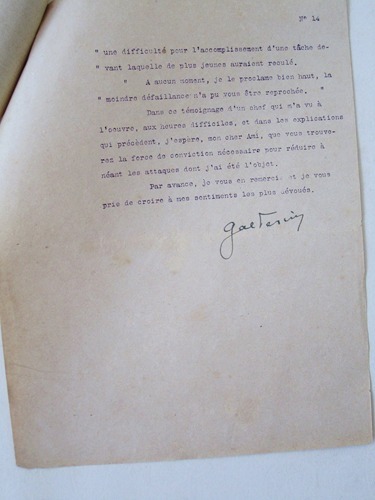
|
|
|
Collectif ; JAWORSKI, Henri ; LABERTHONNIERE, Lucien
Souvenirs d'Henri Jaworski (né le 26 mars 1887), tombé glorieusement pour la défense de la Patrie le 2 Juin 1915 [ Extraordinaire et émouvant lot de documents originaux, correspondance d'un Poilu, livret militaire, permis de conduire, relatifs à la carrière militaire et à la mort d'Henri Jaworski, dans une coffret brodé à son nom ] Dont une L.A.S. de condoléances du philosophe Lucien Laberthonnière
Livret Militaire d'Henri Antoine Jaworski, né le 26 mars 1887, classe 1907, titulaire d'un baccalauréat es Sciences, breveté vélocipédiste et chef de section, très bon tireur récompensé du cro de chasse en drap (livret très abîmé avec mq) / Permis de conduire : Certificat de Capacité valable pour la conduite des voitures à pétrole, délivré le 11/09/1912 / Carnet de la 2e 1/2 section rédigé par le Sergent Jaworski : avec les noms, classes, grades, matricules, campements, outils et professions de ses hommes / 6 Sauf-conduits datés de 1914 et 1915 pour déplacements à Lisieux et de Lisieux à Paris / Plus de 80 lettres (la plupart de sa main, quelques-unes en copie) rédigées par Henri Jaworski de septembre 1914 au 2 juin 1915 (dernière lettre en partie rédigée, le jour de son décès) / L.A.S. d'Auguste Pommier (enveloppe jointe), sous-officier de la 11e Cie du 39 Régt d'Infanterie, datée de 5 mai 1915, adressée au parents d'Henri : Il se réjouit d'apprendre la nomination de son ami au grade de Sous-Lieutenant ; il les remercie également d'avoir accepter de prendre son épouse à leur service / Lettre datée de Maroeuil, le 4 juin 1915, du Sergent-Fourrier David, adressée au parents d'Henri pour leur apprendre le tragique décès de leur fils, mort au combat / Demande de Renseignements du Bureau de Renseignement du Ministère de la Guerre : Dde de confirmation de décès d'Henri Jaworski /Emouvante L.A.S. de la maman d'Henri Jaworski, datée du 29 mai 1915 et manifestement récupérée sur le cadavre de son fils... / Série d'une vingtaine de L.A.S. et de copie de lettres des parents d'Henri Jaworski adressées à leur fils, dont de très émouvantes missives rédigées à son attention après le 2 juin 1915, jour de son décès sur le front / L.A.S. et même lettre dactylographiée de David, sergent-fourrier CHR du 319e relatant à la mère d'Henri Jaworski les circonstances de sa mort, lors de la reprise pour la 3ème fois d'une tranchée allemande / L.A.S de Nestor Derroussent, compagnon d'arme d'Henri Jaworski, exposant aux parents de la victime les circonstances de sa mort. / Lot de 38 lettres, télégrammes ou pneumatiques de condoléances adressés aux parents d'Henri Jaworski dont une belle L.A.S. (à en-tête des Annales de Philosophie Chrétienne) du père Lucien Laberthonnière : "Madame, J'ai appris l'affreux malheur qui vous a frappée. Il s'ajoute, hélas ! à des malheurs sans nombre et semblables qui nous frappent tous les uns après les autres. J'ai trop connu votre fils, et je me suis trop intéressé à lui pour n'être pas cruellement ému de savoir que lui aussi est tombé là-bas comme tant d'autres. Je prends très vivement part à votre peine. Mort glorieuse que celle-là et qui sera féconde. Mais en même temps que c'est là une consolation, combien c'est triste de songer à cette jeunesse emportée brutalement en pleine force et en pleine vie. En même temps que je prie de tout mon coeur pour votre jeune enfant, je demande à Dieu de vous donner le courage et la résignation..." / Avec quelques photos des parents, et 2 photos d'Henri et de son frère Georges, diverses lettres et documents relatifs au sergent Henri Jaworski, dont une étonnante lettre dactylographiée adressée, en réponse par le père d'Henri Jaworski à un ancien condisciple d'Henri à l'Ecole Massillon (Quai des Célestins, Paris) : "Il m'est doux d'apprendre qu'il y a tout de même quelqu'un dans votre maison qui dans l'Elève chassé de son Ecole quinze jours avant ses examens, pour avoir lu le Journal l'Auto en étude, avait reconnu qu'il été doué de certaines qualités"
Bookseller reference : 30048
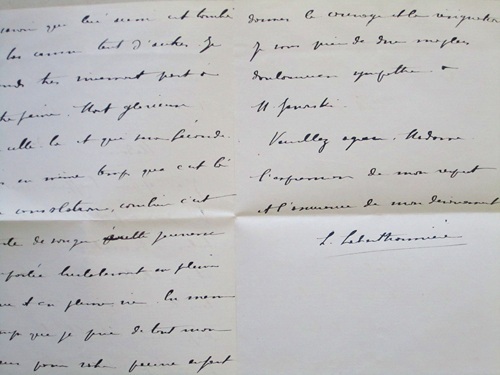
|
|
|
MICHON, Louis
Les Traités Internationaux devant les Chambres. [ Livre dédicacé par l'auteur ]
1 vol. fort in-8 reliure de l'époque bradel demi-toile bleue, A. Chevalier-Marescq & Cie, Paris, 1901
Bookseller reference : 30073
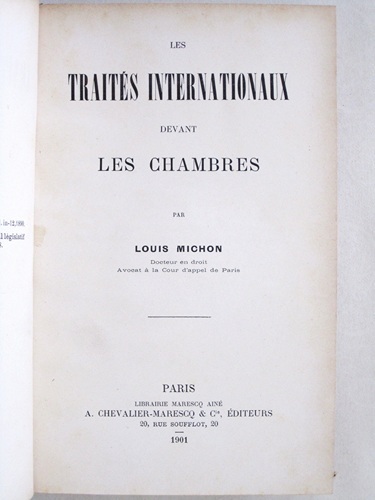
|
|
|
CORBIN, Ch. [ CORBIN, Charles (1831-1904) ]
Théâtre d'amateur. Tome I : Le Cerf-volant. Les Défaillances [ Livre dédicacé par l'auteur ]
Un des 200 exemplaires numérotés hors commerce, 1 vol. in-8 br., Imprimerie Nouvelle Ch. Corbaz, Montreux, 1902, 223 pp.
Bookseller reference : 30075
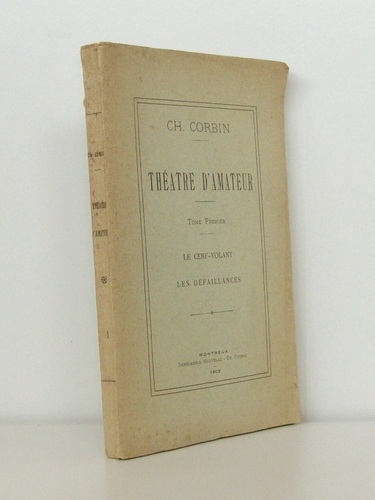
|
|
|
MONZIE, Anatole de (1876-1947)
Les Contes de Saint-Céré [ Dédicacé par l'auteur ] [On joint : ] Petit Manuel de la Russie Nouvelle [ Dédicacé par l'auteur ] [ On joint : ] Ci-devant
3 vol. in-12 reliure uniforme de l'époque demi-veau à coins marbré, dos à 4 nerfs dorés orné en long, couv. cons., Flammarion, 1941, 220 pp., Firmin-Didot, 1931, 332 pp. et une carte dépliante, Gallimard, 1941, 292 pp.
Bookseller reference : 30140
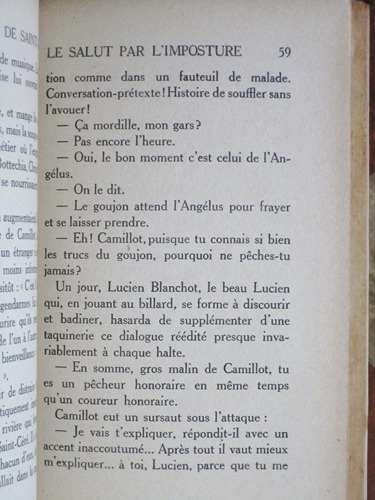
|
|
|
LE VACHER DE BOISVILLE, Dast
Inventaire Sommaire des Registres de La Jurade 1520 à 1783. Tome Premier. [ Livre dédicacé par l'auteur ]
1 vol. in-4 reliure de l'époque demi-basane bleue, Imprimerie G. Gounouilhou, Bordeaux, 1896, XVII-708 pp.
Bookseller reference : 30212

|
|
|
BARCKHAUSEN, H. [ Barckhausen, Henri (1834-1914) ]
Statuts et Règlements de l'Ancienne Université de Bordeaux (1441 - 1793) [ Livre dédicacé par l'auteur ]
Publiés avec préface et notice par H. Barckhausen, 1 vol. in-4 reliure de l'époque, Georges Bouchon, Libourne, Bordeaux, 1886, LIV-168 pp. et 2 ff. n. ch., 1 f. blanc
Bookseller reference : 30213
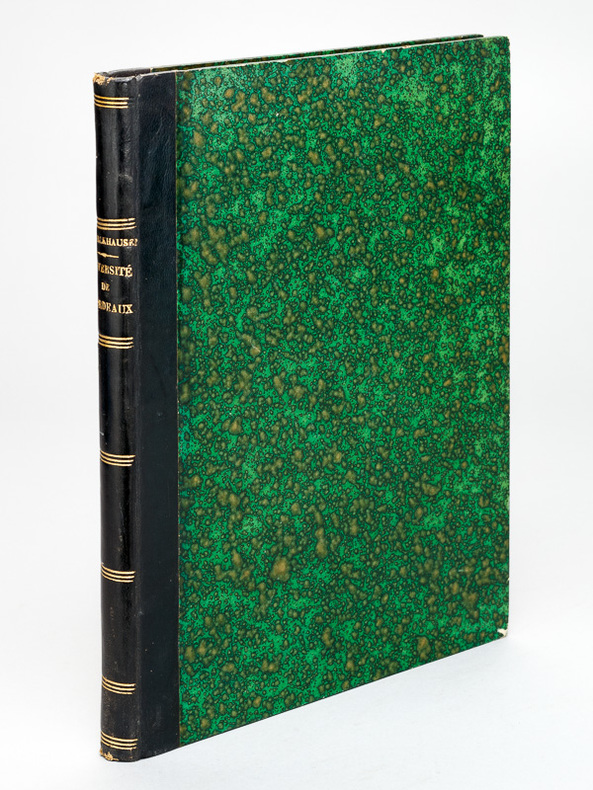
|
|
|
HOCHART, Polydore
Etudes sur la Vie de Sénèque. [ Exemplaire de l'auteur annoté et corrigé de sa main ]
1 vol. grand in-8 reliure de l'époque demi-basane mauve, Ernest Leroux, Paris, 1885, 285 pp.
Bookseller reference : 30238
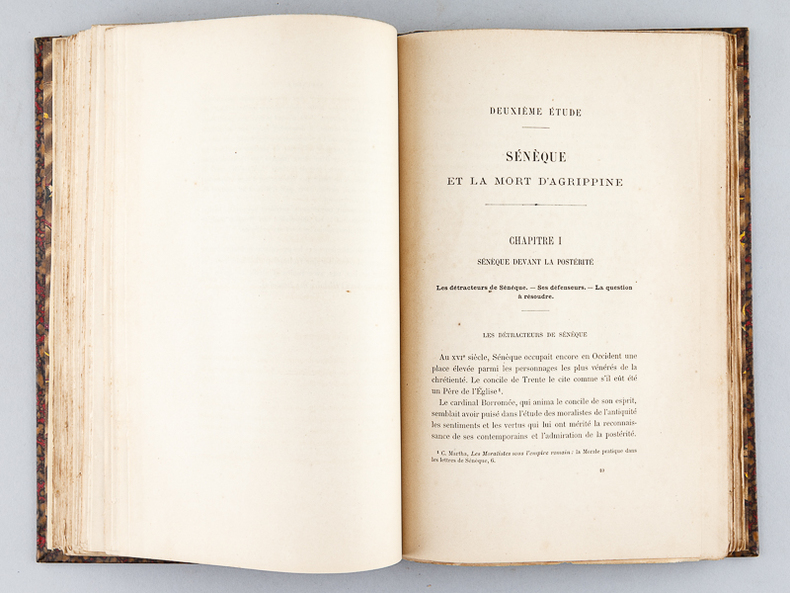
|
|
|
HOCHART, Polydore
Etudes au sujet de la Persécution des Chrétiens sous Néron. [ Exemplaire de l'auteur annoté et corrigé de sa main ]
1 vol. grand in-8 reliure de l'époque demi-basane mauve, Ernest Leroux, Paris, 1885, 320 pp.
Bookseller reference : 30239
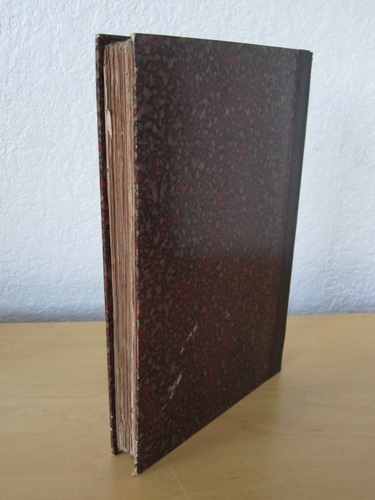
|
|
|
HOCHART, Polydore
De l'Authenticité des Annales et des Histoires de Tacite. [ Exemplaire de l'auteur annoté et corrigé de sa main ]
Ouvrage accompagné des photographies de cinq pages des manuscrits de Florence et de 68 Lettres de Poggio Bracciolini, 1 vol. grand in-8 reliure de l'époque demi-basane mauve, Ernest Thorin, Paris, 1890, 320 pp.
Bookseller reference : 30240

|
|
|
HOCHART, Polydore
Nouvelles Considérations au sujet des Annales et des Histoires de Tacite. [ Exemplaire de l'auteur annoté et corrigé de sa main ]
Ouvrage accompagné des photographies de cinq pages des manuscrits de Florence et de 68 Lettres de Poggio Bracciolini, 1 vol. grand in-8 reliure de l'époque demi-basane mauve, Ernest Thorin, Paris, 1894, XIX-293 pp.
Bookseller reference : 30241
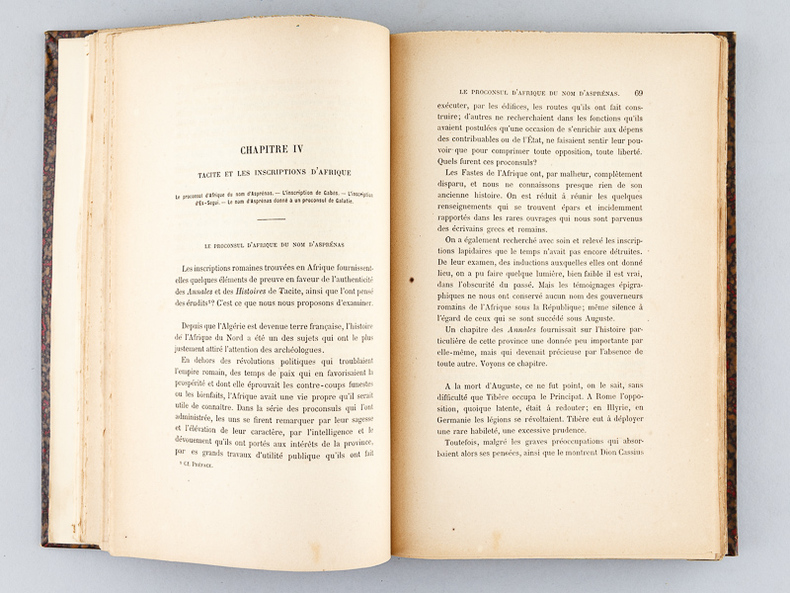
|
|
|
HOCHART, Polydore
Etudes d'Histoire Religieuse. [ Exemplaire de l'auteur annoté et corrigé de sa main ]
Ouvrage accompagné des photographies de cinq pages des manuscrits de Florence et de 68 Lettres de Poggio Bracciolini, 1 vol. grand in-8 reliure de l'époque demi-basane mauve, Ernest Thorin, Paris, 1890, 419 pp.
Bookseller reference : 30242
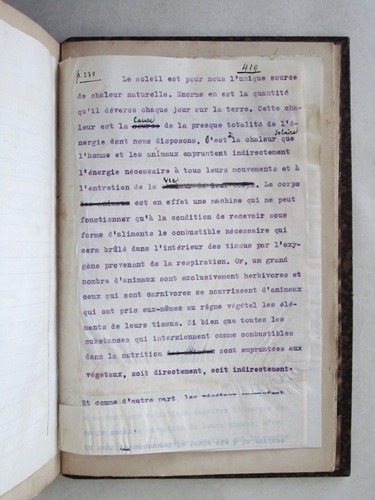
|
|
|
BORDESSOULES, Roger
[ Correspondance datant de la seconde guerre, d'un prisonnier français à sa famille vivant à Captieux, près de Langon, Gironde ] Lot de 54 lettres de Georges Bordessoules, prisonnier dans les Stalags, 179, 249, 224, 214, etc., adressées de 1941 à fin 1944, pour la plupart adressées à son épouse Ida, résidant à Captieux, Gironde.
54 L.A.S, sur papier pré-imprimé "Krieggefangenenpost", de 1941 à fin 1944, à destination d'Ida Bordessoules, Captieux, route nationale, Langon, Gironde : [ Correspondance datant de la seconde guerre, d'un prisonnier français à sa famille vivant à Captieux, près de Langon, Gironde ] Lot de 54 lettres de Georges Bordessoules, prisonnier dans les Stalags, 179, 249, 224, 214, etc., adressées de 1941 à fin 1944, pour la plupart adressées à son épouse Ida, résidant à Captieux, Gironde.
Bookseller reference : 30387
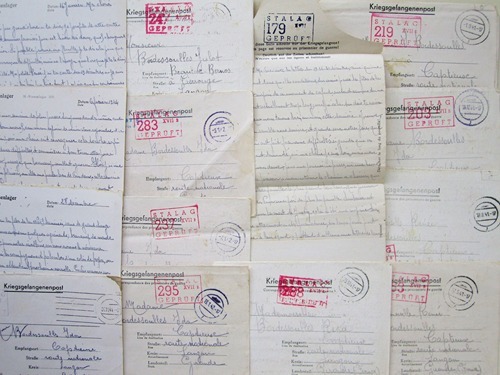
|
|
|
P. BLANQUET ; A. BAGHDIANTZ ; M. CROIZET ; A.M. MOURA
La Calcitonine [ exemplaire dédicacé par l'un des auteurs ].
1 vol. in-8 br., Imprimerie J. Péchade, Bordeaux, 1971, 190 pp.
Bookseller reference : 30506

|
|
|
MIALANE, Pierre
La Corrida... et quelque chose de plus [ Livre dédicacé par l'auteur ]
Edition originale numérotée, 1 vol. in-8 br., Imprimerie Barnier, Nîmes, 1976, 187 pp.
Bookseller reference : 30551
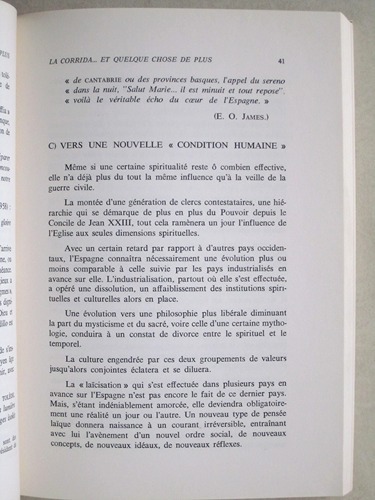
|
|
|
RHEIMS, Maurice
Lettre signée de Maurice Rheims au journaliste Albert Rèche, date du 21 avril 1960 : "Cher Monsieur, je tiens à vous remercier tout particulièrement du remarquable "papier" que vous avez bien voulu consacrer à mon livre. Je vous écris aussi pour vous dire combien j'ai intéressé par la critique que vous avez faite de la méthode Fourastié, et j'avoue bien volontiers qu'elle vous donne raison par les exemples que vous citez. D'un autre côté, il semble bien que parmi toutes celles employées jusqu'à présent, celle-ci tend à se rapprocher le plus de la réalité. Toute autre méthode basée sur l'or ou les matières premières nous a donné des surprises insolites bien plus grandes encore. Je serais intéressé, étant donné l'intérêt que vous avez bien voulu porter à mon livre et par votre critique à ce que vous y réfléchissiez et que vous me donniez plus précisément votre sentiment sur la possibilité d'être plus précis [ ... ] "
1 lettres lignée tapuscrite, date de Paris, le 21 avril 1960, 1 page sous enveloppe
Bookseller reference : 50665

|
|
|
TOURNIER, Yves
Splendeur et Décadence de l'Artillerie Française [ Livre dédicacé par l'auteur ] Conférence donnée à la Société d'Histoire Militaire La Sabretache, le 12 mars 1949
Tapuscrit de 72 pages monté dans une reliure mobile format in-4, 12 mars 1949
Bookseller reference : 50687

|
|
|
TOURNIER, Yves
Les Trois Miracles de la Cathédrale Gothique [ Livre dédicacé par l'auteur ] Causerie faite chez le Docteur R. le 11 avril 1948
Tapuscrit de 53 pages et 2 ff. monté dans une reliure mobile format in-4, Centre de Liaison & d'Etudes, Paris, 16 juillet 1948
Bookseller reference : 50688

|
|
|
MARTHON, Martial
A l'ombre du châtaignier et dans les clairières. [ Edition originale - Livre dédicacé par l'auteur ]
Illustrations du docteur André Mazeyrie et d'Albert Brival, préface de Marcel-Pierre Rollin, 1 vol. in-8 br., Editions Maugein, Tulle, 1951, 162 pp.
Bookseller reference : 50738
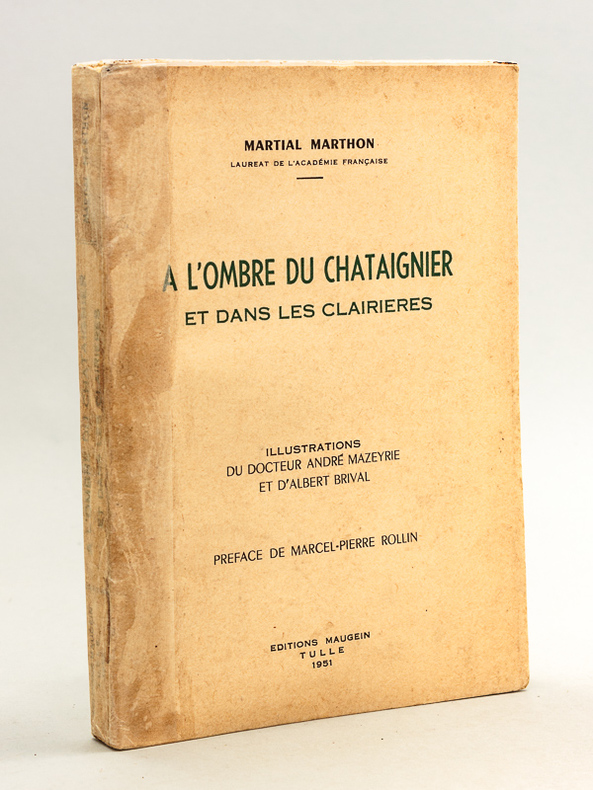
|
|
|
WIAME, Sarah ; BENCHEIKH, Jamel Eddine
Masques. Sarah Wiame. Peintures Collages - Jamel Eddine Bencheikh. Préface Poèmes [ Edition originale - Livre dédicacé par l'auteur et l'illustrateur]
1 vol. in-8 br., Sarah Wiame, s.d. [ circa 1992 ], 16 ff.
Bookseller reference : 50763

|
|
|
DE KERLECQ, Jean ; [ CHANTEPIE, Robert-Frédéric-Louis ]
Le Secret de Salvayre. Comédie en deux Actes tirée d'une nouvelle de Jean Reibrach. Avec 3 billets autographes signés de l'auteur dont une L.A.S. datée du 1er avril 1913 : "Je vous adresse les épreuves de mon article ; en réduisant les blancs et en tassant bien j'espère que vous arriverez à caser tout cela. Je compte sur votre obligeance pour cela. Le "Messager" ne donne rien, rien... rien... et malgré son prix de revient peu élevé, c'est à peine si je couvre, pour ma part, le 1/4 de ce qu'il me coute ; aussi est-il a peu près certain que l'essai que je tente ce mois est, en ce qui me concerne, très probablement le dernier"
1 brochure in-12, L'Edition Populaire, Paris, 1909, 40 pp. avec une L.A.S. rédigée recto verso, une carte de visite rédigée au verso et une carte rédigée.Rappel du titre complet : Le Secret de Salvayre. Comédie en deux Actes tirée d'une nouvelle de Jean Reibrach. Avec 3 billets autographes signés de l'auteur dont une L.A.S. datée du 1er avril 1913 : "Je vous adresse les épreuves de mon article ; en réduisant les blancs et en tassant bien j'espère que vous arriverez à caser tout cela. Je compte sur votre obligeance pour cela. Le "Messager" ne donne rien, rien... rien... et malgré son prix de revient peu élevé, c'est à peine si je couvre, pour ma part, le 1/4 de ce qu'il me coute ; aussi est-il a peu près certain que l'essai que je tente ce mois est, en ce qui me concerne, très probablement le dernier"
Bookseller reference : 50801
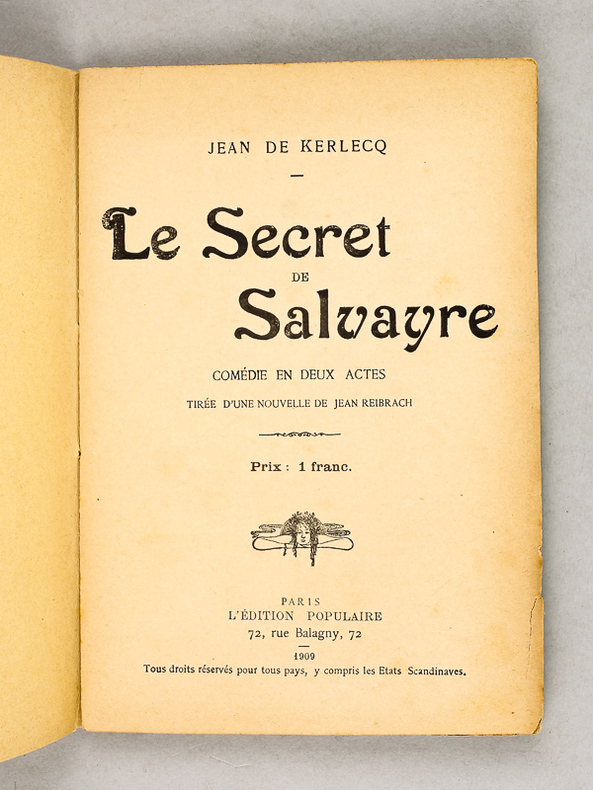
|
|
|
DOUTRE, Daniel
L'Empreinte [ Edition originale - Livre dédicacé par l'auteur ]
Illustrations de Patricia Le Gal, 1 vol. in-8 cartonnage éditeur, Editions du Terroir, Impression Barreau Niort, 1985, 60 pp.
Bookseller reference : 50807
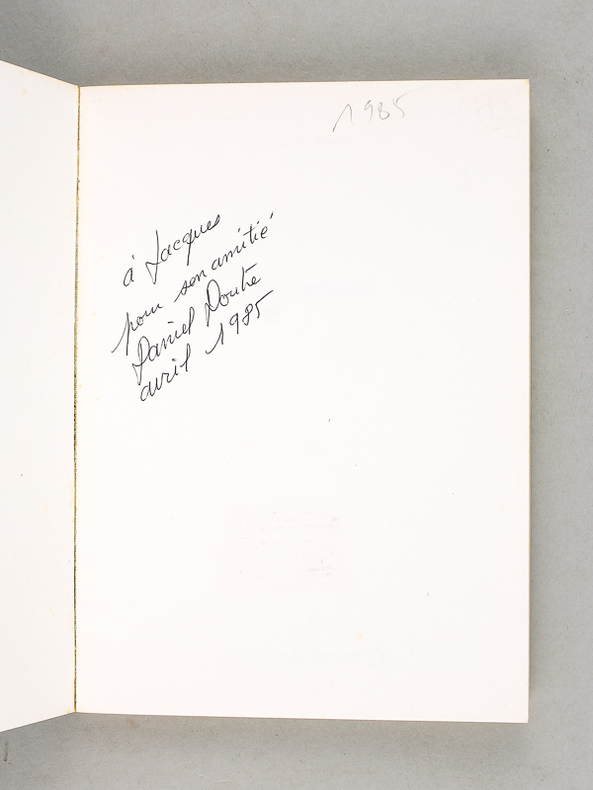
|
|
|
CAT, E.
Précis d'Histoire de la Révolution. Livre Premier : L'Assemblée Nationale Constituante [ Livre dédicacé par l'auteur ]
1 vol. in-12 reliure demi-basane rouge, Edition de 'L'Education Sociale", Alger, 1902, 222 pp.
Bookseller reference : 50829
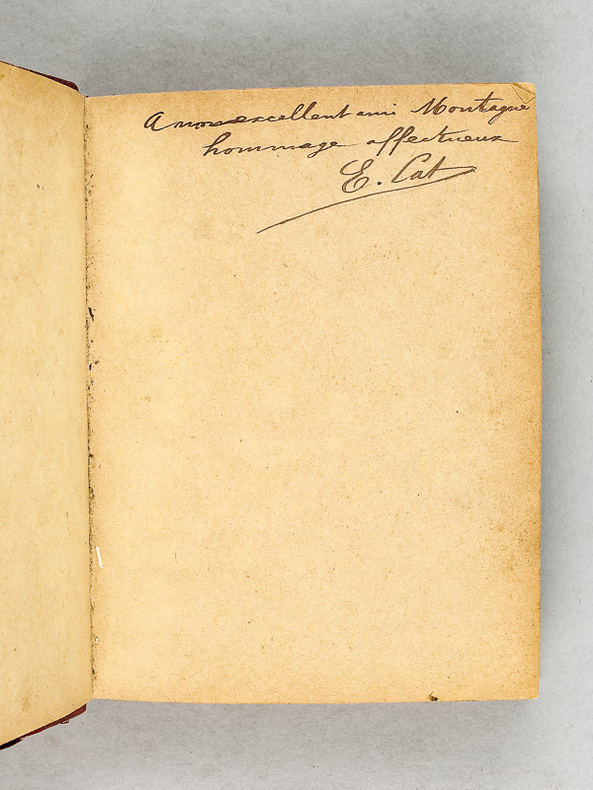
|
|
|
ALDE , Maison de ventes spécialisée Livres et Autographes ; DELCAMP, Jérôme Commissaire-Priseur
Bibliothèque oenologique Bernard Chwartz , Ventes aux enchères publiques, les lundi 11 mars et mardi 12 avril 2011, Salle Rossini, Paris
1 vol. in-4 br., ill. couleurs ou noir et blanc, Alde, Paris, 2011, 524 lots avec leurs estimations. On joint la liste des résultats obtenus.
Bookseller reference : 50970

|
|
|
JACK, Muriel
Herbadore. Poèmes. [ Edition originale - Livre dédicacé par l'auteur ]
1 vol. in-12 br., Editions de la Revue Moderne, Paris, 1965, 91 pp.
Bookseller reference : 51100

|
|
|
SALLES, Antoine
Un Voyage parlementaire en Tunisie. Mai 1935 [ Edition originale - Livre dédicacé par l'auteur ]
1 vol. in-8 br., Imprimerie du "Salut Public", Lyon, Mai 1935, 139 pp.
Bookseller reference : 51101

|
|
|
DUBREUIL, Ferdinand ; BERR, Georges
Chinon. Visions du Passé. Vingt-cinq bois originaux de Ferdinand Dubreuil [ Edition originale - Livre dédicacé par l'auteur ]
Un des 260 exemplaires sur papier Chatélio crème Montgolfier frères numérotés (n°97), 1 vol. in-4 en feuillets sous chemise (sans étui), Sur les Presses du Maître-Imprimeur Albert Arrault, Tours, 1935, 1 f. de titre, 1 f. (réclame pour la souscription), 5 ff. (préface) et 25 planches numérotées et signées par l'auteur (dont 20 horx-texte), 4 ff. (achevé d'imprimer, liste des souscripteurs, table), ave 5 ff. supplémentaires joints
Bookseller reference : 51104

|
|
|
GOSSET, Edouard ; [ DE BUXEUIL, René ]
Lot de 28 feuillets manuscrits de partitions musicales : La Saison des Folies (Batterie, Batterie, Flûte, Clarinette, 1er Violon) - Définitions (Flûte, 2e Violon, Alto, Clarinette Si, 1er Violon, Conducteur Chef) - Mes Trois Amoureux (Clarinette, Flûte, 2e Violon, Alto, 1er Violon - C'est la Fille du Moulin (Flûte, Clarinette en La, Pistons, Trombone, Batterie, Violoncelle, Contrebasse, 1er Violon, 1er Violon - Ma Petite Line (Clarinette, Flûte, 1er Violon)
28 feuillets manuscrits, avec cachet d'Edouard Gosset, "Compositeur de Musique, Pianiste, Chef d'Orchestre 68 Boulevard de l'Hôpital, Paris", s.d. [ circa 1935 ]. Rappel du titre complet : Lot de 28 feuillets manuscrits de partitions musicales : La Saison des Folies (Batterie, Batterie, Flûte, Clarinette, 1er Violon) - Définitions (Flûte, 2e Violon, Alto, Clarinette Si, 1er Violon, Conducteur Chef) - Mes Trois Amoureux (Clarinette, Flûte, 2e Violon, Alto, 1er Violon - C'est la Fille du Moulin (Flûte, Clarinette en La, Pistons, Trombone, Batterie, Violoncelle, Contrebasse, 1er Violon, 1er Violon - Ma Petite Line (Clarinette, Flûte, 1er Violon)
Bookseller reference : 51105
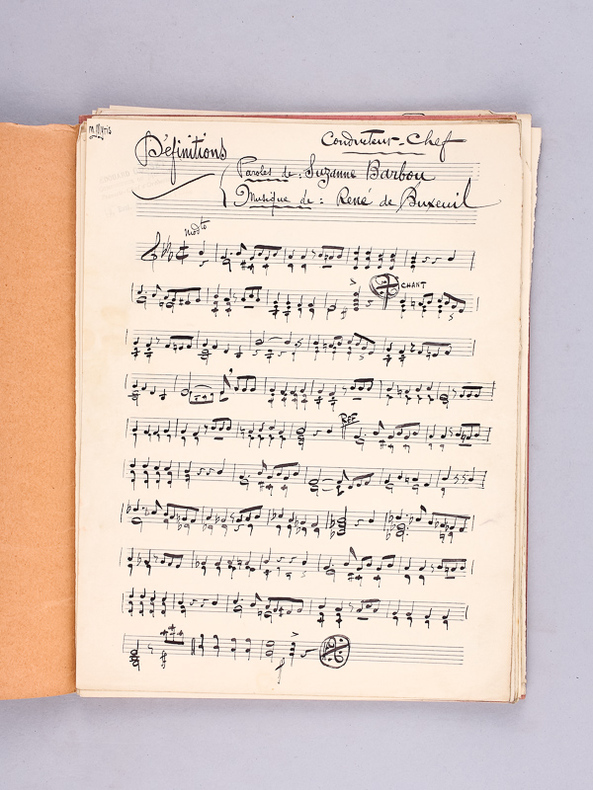
|
|
|
SILVESTRE, Armand
Contes Grassouillets [ Livre dédicacé par l'auteur ]
1 vol. in-12 reliure demi-chagrin maroquiné rouge, dos à 3 nerfs, tête dorée, Marpon et E. Flammarion, Paris, s.d. [ circa 1883 ], 280 pp.
Bookseller reference : 51126

|
|
|
PREVOST, Marcel
Chonchette [ Livre dédicacé par l'auteur ]
1 vol. in-12 reliure demi-chagrin maroquiné rouge, dos à 3 nerfs, tête dorée,Alphonse Lemerre, 1888, 351 pp.
Bookseller reference : 51127

|
|
|
CLARETIE, Jules
Jean Mornas [ Livre dédicacé par l'auteur ]
1 vol. in-12 reliure demi-chagrin maroquiné rouge, dos à 3 nerfs, E. Dentu, Paris, 1885, 372 pp.
Bookseller reference : 51128
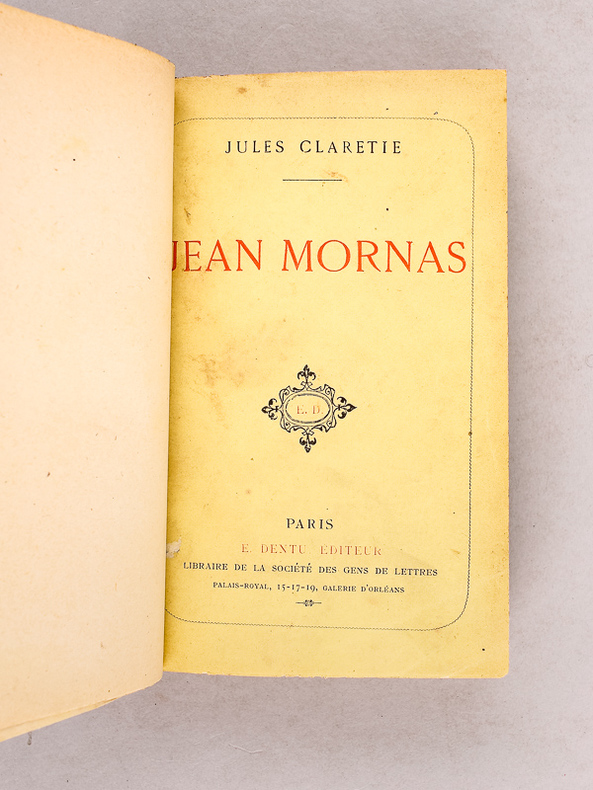
|
|
|
PETITCLERC, Paul
Essai sur la Faune du Callovien du Département des Deux-Sèvres et, plus spécialement, de celle des environs de Niort (Texte et Atlas - Complet) [ Edition originale - Livre dédicacé par l'auteur ]
Contribution à l'étude des Terrains Jurassiques dans l'Ouest de la France, 1 vol. in-8 br. et 1 vol. en feuillet sous chemise, Librairie et Imprimerie Louis Bon, Vesoul (Haute-Saône), 1915, 151 pp. et 11 pp. avec 14 planches et légendes
Bookseller reference : 51180
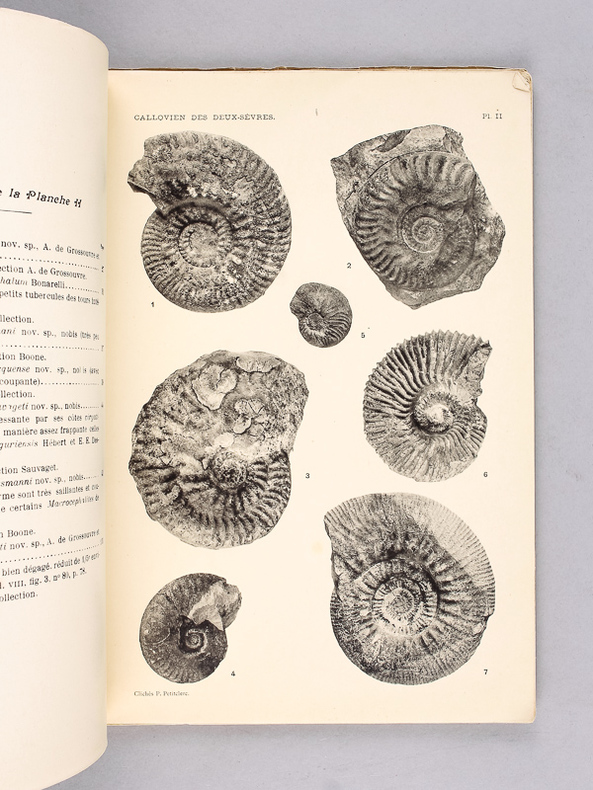
|
|
|
HARTOG, Willie G.
Guilbert de Pixerécourt. Sa vie, son mélodrame, sa technique et son influence [ Edition originale - Livre dédicacé par l'auteur ]
1 vol. in-8 br., Librairie ancienne Honoré Champion, Paris, 1913, 264 pp.
Bookseller reference : 51182

|
|
|